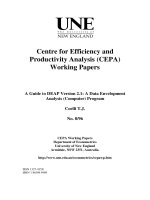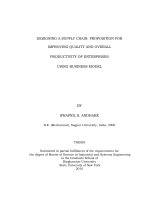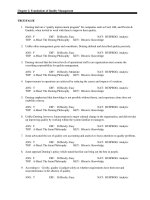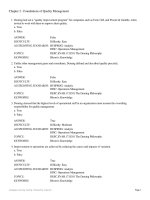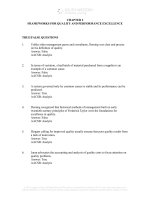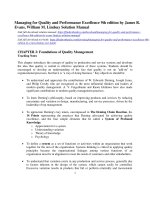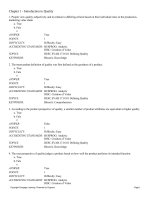SIX SIGMA FOR QUALITY AND PRODUCTIVITY PROMOTION
Bạn đang xem bản rút gọn của tài liệu. Xem và tải ngay bản đầy đủ của tài liệu tại đây (1.41 MB, 218 trang )
Productivity Series 32
From:
Six Sigma for Quality
and Productivity
Promotion
©APO 2003, ISBN: 92-833-1722-X
by Sung H. Park
Published by the Asian Productivity Organization
1-2-10 Hirakawacho, Chiyoda-ku, Tokyo 102-0093, Japan
Tel: (81-3) 5226 3920 • Fax: (81-3) 5226 3950
E-mail: • URL: www.apo-tokyo.org
Disclaimer and Permission to Use
This publication is provided in PDF format for educational use. It
may be copied and reproduced for personal use only. For all
other purposes, the APO's permission must first be obtained.
The responsibility for opinions and factual matter as expressed in
this document rests solely with its author(s), and its publication
does not constitute an endorsement by the APO of any such
expressed opinion, nor is it affirmation of the accuracy of information herein provided.
Bound editions of the publication may be available for limited purchase. Order forms may be downloaded from the APO's web site.
23 seireS ytivitcudorP
SIX
SIGMA
FOR QUALITY AND
PRODUCTIVITY PROMOTION
kraP .H gnuS
ASIAN PRODUCTIVITY ORGANIZATION
SIX
SIGMA
FOR QUALITY AND
PRODUCTIVITY PROMOTION
kraP .H gnuS
2003
ASIAN PRODUCTIVITY ORGANIZATION
© Asian Productivity Organization, 2003
ISBN: 92-833-1722-X
The opinions expressed in this publication do not necessarily reflect the
official view of the APO. For reproduction of the contents in part or in
full, the APO’s prior permission is required.
TABLE OF CONTENTS
Preface . . . . . . . . . . . . . . . . . . . . . . . . . . . . . . . . . . . . . . .v
1. Six Sigma Overview
1.1 What is Six Sigma? . . . . . . . . . . . . . . . . . . . . . . . . 1
1.2 Why is Six Sigma Fascinating? . . . . . . . . . . . . . . . 2
1.3 Key Concepts of Management . . . . . . . . . . . . . . . . 5
1.4 Measurement of Process Performance . . . . . . . . . 11
1.5 Relationship between Quality and Productivity . 27
2. Six Sigma Framework
2.1 Five Elements of the Six Sigma Framework . . . . 30
2.2 Top-level Management Commitment and
Stakeholder Involvement . . . . . . . . . . . . . . . . . . . 31
2.3 Training Scheme and Measurement System . . . . 34
2.4 DMAIC Process . . . . . . . . . . . . . . . . . . . . . . . . . . 37
2.5 Project Team Activities . . . . . . . . . . . . . . . . . . . . 41
2.6 Design for Six Sigma . . . . . . . . . . . . . . . . . . . . . . 45
2.7 Transactional/Service Six Sigma . . . . . . . . . . . . . 48
3. Six Sigma Experiences and Leadership
3.1 Motorola: The Cradle of Six Sigma . . . . . . . . . . . 51
3.2 General Electric: The Missionary of Six Sigma . . 54
3.3 Asea Brown Boveri: First European Company to
Succeed with Six Sigma . . . . . . . . . . . . . . . . . . . 56
3.4 Samsung SDI: A Leader of Six Sigma in Korea . . 60
3.5 Digital Appliance Company of LG Electronics:
Success Story with Six Sigma . . . . . . . . . . . . . . . 67
i
Six Sigma for Quality and Productivity Promotion
4. Basic QC and Six Sigma Tools
4.1 The 7 QC Tools . . . . . . . . . . . . . . . . . . . . . . . . . . 74
4.2 Process Flowchart and Process Mapping . . . . . . 85
4.3 Quality Function Deployment (QFD) . . . . . . . . . 88
4.4 Hypothesis Testing . . . . . . . . . . . . . . . . . . . . . . . 96
4.5 Correlation and Regression . . . . . . . . . . . . . . . . . 99
4.6 Design of Experiments (DOE) . . . . . . . . . . . . . . 104
4.7 Failure Modes and Effects Analysis (FMEA) . . . 112
4.8 Balanced Scorecard (BSC) . . . . . . . . . . . . . . . . . 118
5. Six Sigma and Other Management Initiatives
5.1 Quality Cost and Six Sigma . . . . . . . . . . . . . . . . 122
5.2 TQM and Six Sigma . . . . . . . . . . . . . . . . . . . . . 126
5.3 ISO 9000 Series and Six Sigma . . . . . . . . . . . . . 129
5.4 Lean Manufacturing and Six Sigma . . . . . . . . . . 131
5.5 National Quality Awards and Six Sigma . . . . . . 134
6. Further Issues for Implementation of Six Sigma
6.1 Seven Steps for Six Sigma Introduction . . . . . . 136
6.2 IT, DT and Six Sigma . . . . . . . . . . . . . . . . . . . . . 138
6.3 Knowledge Management and Six Sigma . . . . . . 143
6.4 Six Sigma for e-business . . . . . . . . . . . . . . . . . . 146
6.5 Seven-step Roadmap for Six Sigma
Implementation . . . . . . . . . . . . . . . . . . . . . . . . . 147
ii
Table of Contents
7. Practical Questions in Implementing Six Sigma
7.1 Is Six Sigma Right for Us Now? . . . . . . . . . . . . 151
7.2 How Should We Initate Our Efforts for
Six Sigma? . . . . . . . . . . . . . . . . . . . . . . . . . . . . . 153
7.3 Does Six Sigma Apply Well to Service
Industries? . . . . . . . . . . . . . . . . . . . . . . . . . . . . . 155
7.4 What is a Good Black Belt Course? . . . . . . . . . . 156
7.5 What are the Keys for Six Sigma Success? . . . . 160
7.6 What is the Main Criticism of Six Sigma? . . . . . 162
8. Case Studies of Six Sigma Improvement Projects
8.1 Manufacturing Applications:
Microwave Oven Leakage . . . . . . . . . . . . . . . . . 165
8.2 Non-manufacturing Applications: Development
of an Efficient Computerized Control System . . 172
8.3 R&D Applications: Design Optimization of
Inner Shield of Omega CPT . . . . . . . . . . . . . . . . 178
Appendices
Table of Acronyms . . . . . . . . . . . . . . . . . . . . . . . . . . 187
A-1 Standard Normal Distribution Table . . . . . . . . . 189
A-2 t-distribution Table of t(f;a) . . . . . . . . . . . . . . . . 190
A-3 F-distribution Table of F(f1, f2;a) . . . . . . . . . . . . 191
A-4 Control Limits for Various Control Charts . . . . . 195
A-5 GE Quality 2000: A Dream with a Great Plan . . 196
References . . . . . . . . . . . . . . . . . . . . . . . . . . . . . . . . 200
Index . . . . . . . . . . . . . . . . . . . . . . . . . . . . . . . . . . . . . .203
iii
PREFACE
This book has been written primarily for company managers
and engineers in Asia who wish to grasp Six Sigma concepts,
methodologies, and tools for quality and productivity promotion
in their companies. However, this book will also be of interest to
researchers, quality and productivity specialists, public sector
employees, students and other professionals with an interest in
quality management in general.
I have been actively involved over the last 20 years in industrial statistics and quality management teaching and consultation
as a professor and as a private consultant. Six Sigma was recently introduced into Korea around 1997, and I have found that Six
Sigma is extremely effective for quality and productivity innovation in Korean companies. I have written two books on Six
Sigma in Korean; one titled “The Theory and Practice of Six
Sigma,” and the other called “Design for Six Sigma,” which are
both best-sellers in Korea. In 2001, I had the honor of being
invited to the “Symposium on Concept and Management of Six
Sigma for Productivity Improvement” sponsored by the Asian
Productivity Organization (APO) during 7–9 August as an invited speaker. I met many practitioners from 15 Asian countries,
and I was very much inspired and motivated by their enthusiasm
and desire to learn Six Sigma. Subsequently, Dr. A.K.P. Mochtan,
Program Officer of the Research & Planning Department, APO,
came to me with an offer to write a book on Six Sigma as an
APO publication. I gladly accepted his offer, because I wanted to
share my experiences of Six Sigma with engineers and
researchers in Asian countries, and I also desired a great
improvement in quality and productivity in Asian countries to
attain global competitiveness in the world market.
This book has three main streams. The first is to introduce an
overview of Six Sigma, framework, and experiences (Chapters
1–3). The second is to explain Six Sigma tools, other management initiatives and some practical issues related to Six Sigma
(Chapters 4–6). The third is to discuss practical questions in
implementing Six Sigma and to present real case studies of
v
Six Sigma for Quality and Productivity Promotion
improvement projects (Chapters 7–8). This book can be used as
a textbook or a guideline for a Champion or Master Black Belt
course in Six Sigma training.
I would like to thank Dr. A.K.P. Mochtan and Director
Yoshikuni Ohnishi of APO, who allowed me to write this book
as an APO publication. I very much appreciate the assistance of
Professor Moon W. Suh at North Carolina State University who
examined the manuscript in detail and greatly improved the
readability of the book. Great thanks should be given to Mr. Hui
J. Park and Mr. Bong G. Park, two of my doctoral students, for
undertaking the lengthy task of MS word processing of the manuscript. I would especially like to thank Dr. Dag Kroslid, a
Swedish Six Sigma consultant, for inspiring me to write this book
and for valuable discussions on certain specific topics in the
book.
Finally, I want to dedicate this book to God for giving me the
necessary energy, health, and inspiration to finish the manuscript.
vi
1. Six Sigma Overview
1.1 What is Six Sigma?
Sigma (σ ) is a letter in the Greek alphabet that has become
the statistical symbol and metric of process variation. The
sigma scale of measure is perfectly correlated to such characteristics as defects-per-unit, parts-per-million defectives, and
the probability of a failure. Six is the number of sigma measured in a process, when the variation around the target is
such that only 3.4 outputs out of one million are defects under
the assumption that the process average may drift over the
long term by as much as 1.5 standard deviations.
Six Sigma may be defined in several ways. Tomkins (1997)
defines Six Sigma to be “a program aimed at the near-elimination of defects from every product, process and transaction.” Harry (1998) defines Six Sigma to be “a strategic initiative to boost profitability, increase market share and
improve customer satisfaction through statistical tools that
can lead to breakthrough quantum gains in quality.”
Six Sigma was launched by Motorola in 1987. It was the
result of a series of changes in the quality area starting in the
late 1970s, with ambitious ten-fold improvement drives. The
top-level management along with CEO Robert Galvin developed a concept called Six Sigma. After some internal pilot
implementations, Galvin, in 1987, formulated the goal of
“achieving Six-Sigma capability by 1992” in a memo to all
Motorola employees (Bhote, 1989). The results in terms of
reduction in process variation were on-track and cost savings
totalled US$13 billion and improvement in labor productivity
achieved 204% increase over the period 1987–1997
(Losianowycz, 1999).
In the wake of successes at Motorola, some leading electronic companies such as IBM, DEC, and Texas Instruments
launched Six Sigma initiatives in early 1990s. However, it was
1
Six Sigma for Quality and Productivity Promotion
not until 1995 when GE and Allied Signal launched Six Sigma
as strategic initiatives that a rapid dissemination took place in
non-electronic industries all over the world (Hendricks and
Kelbaugh, 1998). In early 1997, the Samsung and LG Groups
in Korea began to introduce Six Sigma within their companies. The results were amazingly good in those companies. For
instance, Samsung SDI, which is a company under the Samsung Group, reported that the cost savings by Six Sigma projects totalled US$150 million (Samsung SDI, 2000a). At the
present time, the number of large companies applying Six
Sigma in Korea is growing exponentially, with a strong vertical deployment into many small- and medium-size enterprises
as well.
As a result of consulting experiences with Six Sigma in
Korea, the author (Park et. al., 1999) believes that Six Sigma is
a “new strategic paradigm of management innovation for company survival in this 21st century, which implies three things:
statistical measurement, management strategy and quality culture.” It tells us how good our products, services and processes really are through statistical measurement of quality level. It
is a new management strategy under leadership of top-level
management to create quality innovation and total customer
satisfaction. It is also a quality culture. It provides a means of
doing things right the first time and to work smarter by using
data information. It also provides an atmosphere for solving
many CTQ (critical-to-quality) problems through team efforts.
CTQ could be a critical process/product result characteristic to
quality, or a critical reason to quality characteristic. The former is termed as CTQy, and the latter CTQx.
1.2 Why is Six Sigma Fascinating?
Six Sigma has become very popular throughout the whole
world. There are several reasons for this popularity. First, it is
regarded as a fresh quality management strategy which can
replace TQC, TQM and others. In a sense, we can view the
development process of Six Sigma as shown in Figure 1.1.
2
Six Sigma Overview
Many companies, which were not quite successful in implementing previous management strategies such as TQC and
TQM, are eager to introduce Six Sigma.
QC
SQC
TQC
ISO 9000
Series
TQM
Six Sigma
Scientific
management tools
such as SPC, TPM,
QE and TCS
Figure 1.1. Development process of Six Sigma in quality management
Six Sigma is viewed as a systematic, scientific, statistical
and smarter (4S) approach for management innovation which
is quite suitable for use in a knowledge-based information
society. The essence of Six Sigma is the integration of four elements (customer, process, manpower and strategy) to provide
management innovation as shown in Figure 1.2.
Customer
Process
Manpower
Strategy
Six Sigma
Management
innovation
Systematic and
Scientific Approach
Figure 1.2. Essence of Six Sigma
Six Sigma provides a scientific and statistical basis for quality assessment for all processes through measurement of quality
levels. The Six Sigma method allows us to draw comparisons
among all processes, and tells how good a process is. Through
this information, top-level management learns what path to follow to achieve process innovation and customer satisfaction.
Second, Six Sigma provides efficient manpower cultivation
and utilization. It employs a “belt system” in which the levels
of mastery are classified as green belt, black belt, master black
belt and champion. As a person in a company obtains certain
3
Six Sigma for Quality and Productivity Promotion
training, he acquires a belt. Usually, a black belt is the leader
of a project team and several green belts work together for the
project team.
Third, there are many success stories of Six Sigma application in well known world-class companies. As mentioned
earlier, Six Sigma was pioneered by Motorola and launched
as a strategic initiative in 1987. Since then, and particularly from 1995, an exponentially growing number of prestigious global firms have launched a Six Sigma program. It
has been noted that many globally leading companies run
Six Sigma programs (see Figure 3), and it has been well
known that Motorola, GE, Allied Signal, IBM, DEC, Texas
Instruments, Sony, Kodak, Nokia, and Philips Electronics
among others have been quite successful in Six Sigma. In
Korea, the Samsung, LG, Hyundai groups and Korea Heavy
Industries & Construction Company have been quite successful with Six Sigma.
Lastly, Six Sigma provides flexibility in the new millennium
of 3Cs, which are:
• Change: Changing society
• Customer: Power is shifted to customer and customer
demand is high
• Competition: Competition in quality and productivity
The pace of change during the last decade has been unprecedented, and the speed of change in this new millennium is perhaps faster than ever before. Most notably, the power has shifted from producer to customer. The producer-oriented industrial society is over, and the customer-oriented information society has arrived. The customer has all the rights to order, select
and buy goods and services. Especially, in e-business, the customer has all-mighty power. Competition in quality and productivity has been ever-increasing. Second-rate quality goods
cannot survive anymore in the market. Six Sigma with its 4S
(systematic, scientific, statistical and smarter) approaches provides flexibility in managing a business unit.
4
Six Sigma Overview
1.3 Key Concepts of Management
The core objective of Six Sigma is to improve the performance of processes. By improving processes, it attempts to
achieve three things: the first is to reduce costs, the second is
to improve customer satisfaction, and the third is to increase
revenue, thereby, increasing profits.
Motorola
IBM
Kodak
DEC
TI
ABB
GE
Allied Signal
1987
1989
1991
1993
1995
Dow Chemical
DuPont
NEC
Samsung SDI
LG Electronics
Sony
Toshiba
Whirlpool
1997
American Express
Johnson & Johnson
Samsung Group
LG Group
Ericsson
NCR
Nokia
Philips
Solectron
US Postal Service
1999
Figure 1.3. Globally well known Six Sigma companies
1.3.1 Process
A general definition of a process is an activity or series of
activities transforming inputs to outputs in a repetitive flow as
shown in Figure 1.4. For companies, the output is predominantly a product taking the form of hardware goods with
their associated services. However, an R&D activity or a nonmanufacturing service activity which does not have any form
of hardware goods could also be a process.
X1
X2
X3
… Xn
Input variables
(control factors)
Process
Process characteristics
Output, Y
Product characteristics
Input variables
(noise factors)
V1
V2
V3 … Vn
Figure 1.4. The process with inputs and outputs
5
Six Sigma for Quality and Productivity Promotion
Literally, the inputs can be anything from labor, materials,
machines, decisions, information and measurements to temperature, humidity and weight. Inputs are either control factors which can be physically controlled, or noise factors which
are considered to be uncontrollable, too costly to control, or
not desirable to control.
The model of Six Sigma in terms of processes and improvement is that y is a function of x and v:
y = f(x1, x2, ..., xk; v1, v2, ..., vm)
Here, y represents the result variable (characteristics of the
process or product), x represents one or more control factors,
and v represents one or more noise factors. The message in the
process is to find the optimal levels of x variables which give
desired values of y as well as being robust to the noise factors
v. The word “robust” means that the y values are not changed
much as the levels of noise factors are changed.
Any given process will have one or more characteristics
specified against which data can be collected. These characteristics are used for measuring process performance. To measure the process performance, we need data for the relevant
characteristics. There are two types of characteristics: continuous and discrete. Continuous characteristics may take any
measured value on a continuous scale, providing continuous
data, whereas discrete characteristics are based on counts,
providing attribute data. Examples of continuous data are
thickness, time, speed and temperature. Typical attribute data
are counts of pass/fail, acceptable/unacceptable, good/bad or
imperfections.
1.3.2 Variation
The data values for any process or product characteristic
always vary. No two products or characteristics are exactly
alike because any process contains many sources of variability. The differences among products may be large, or
they may be immeasurably small, but they are always present. The variation, if the data values are measured, can be
6
Six Sigma Overview
visualized and statistically analyzed by means of a distribution that best fits the observations. This distribution can be
characterized by:
• Location (average value)
• Spread (span of values from smallest to largest)
• Shape (the pattern of variation – whether it is symmetrical, skewed, etc.)
Variation is indeed the number one enemy of quality control. It constitutes a major cause of defectives as well as excess
costs in every company. Six Sigma, through its tracking of
process performance and formalized improvement methodology, focuses on pragmatic solutions for reducing variation.
Variation is the key element of the process performance triangle as shown in Figure 1.5. Variation, which is the most
important, relates to “how close are the measured values to
the target value,” cycle time to “how fast” and yield to “how
much.” Cycle time and yield are the two major elements of
productivity.
Variation
(quality)
Evaluation of process
performance
Cycle time
(productivity)
Yield
Figure 1.5. Process performance triangle
7
Six Sigma for Quality and Productivity Promotion
There are many sources of variation for process and product characteristics. It is common to classify them into two
types: common causes and special causes. Common causes
refer to the sources of variation within a process that have a
stable and repeatable distribution over time. This is called “in
a state of statistical control.” The random variation, which is
inherent in the process, is not easily removable unless we
change the very design of the process or product, and is a
common cause found everywhere. Common causes behave
like a stable system of chance causes. If only common causes
of variation are present and do not change, the output of a
process is predictable as shown in Figure 1.6.
If only common causes of variation
are present, the output of a process
forms a distribution that is stable
over time and is predictable:
TARGET
LINE
PREDICTION
TIME
SIZE
If special causes of variation are
present, the process output is not
stable over time:
TARGET
LINE
PREDICTION
TIME
SIZE
Figure 1.6. Variation: Common and special causes
Special causes (often called assignable causes) refer to any
factors causing variation that are usually not present in the
8
Six Sigma Overview
process. That is, when they occur, they make a change in the
process distribution. Unless all the special causes of variation
are identified and acted upon, they will continue to affect the
process output in unpredictable ways. If special causes are
present, the process output is not stable over time.
1.3.3 Cycle time, yield and productivity
Every process has a cycle time and yield. The cycle time of
a process is the average time required for a single unit to complete the transformation of all input factors into an output.
The yield of a process is the amount of output related to input
time and pieces. A more efficient transformation of input factors into products will inevitably give a better yield.
Productivity is used in many different aspects (see Toru
Sase (2001)). National productivity can be expressed as
GDP/population where GDP means the gross domestic product. Company productivity is generally defined as the “function of the output performance of the individual firm compared with its input.” Productivity for industrial activity has
been defined in many ways, but the following definition proposed by the European Productivity Agency (EPA) in 1958 is
perhaps the best.
• Productivity is the degree of effective utilization of each
element of production.
• Productivity is, above all, an attitude of mind. It is
based on the conviction that one can do things better
today than yesterday, and better tomorrow than today.
It requires never-ending efforts to adapt economic activities to changing conditions, and the application of new
theories and methods. It is a firm belief in the progress
of human beings.
The first paragraph refers to the utilization of production
elements, while the second paragraph explains the social
effects of productivity. Although the product is the main output of an enterprise, other tasks such as R&D activities, sale
of products and other service activities are also closely linked
9
Six Sigma for Quality and Productivity Promotion
to productivity. In economic terms, productivity refers to the
extent to which a firm is able to optimize its management
resources in order to achieve its goals. However, in this book
we adopt the definition of productivity as in the first paragraph, which is narrow in scope. Thus, if cycle time and yield
in the process performance triangle of Figure 1.5 are
improved, productivity can be improved accordingly.
1.3.4 Customer satisfaction
Customer satisfaction is one of the watchwords for company survival in this new 21st century. Customer satisfaction can
be achieved when all the customer requirements are met. Six
Sigma emphasizes that the customer requirements must be fulfilled by measuring and improving processes and products, and
CTQ (critical-to-quality) characteristics are measured on a consistent basis to produce few defects in the eyes of the customer.
The identification of customer requirements is ingrained in
Six Sigma and extended into the activity of translating requirements into important process and product characteristics. As
customers rarely express their views on process and product
characteristics directly, a method called QFD (quality function
deployment) is applied for a systematic translation (see Chapter 4). Using QFD, it is possible to prioritize the importance of
each characteristic based on input from the customer.
Having identified the CTQ requirements, the customer is
usually asked to specify what the desired value for the characteristic is, i.e., target value, and what a defect for the characteristic is, i.e., specification limits. This vital information is
utilized in Six Sigma as a basis for measuring the performance
of processes.
Six Sigma improvement projects are supposed to focus on
improvement of customer satisfaction which eventually gives
increased market share and revenue growth. As a result of revenue growth and cost reduction, the profit increases and the
commitment to the methodology and further improvement
projects are generated throughout the company. This kind of
10
Six Sigma Overview
loop is called “Six Sigma loop of improvement projects,” and
was suggested by Magnusson, et. al. (2001). This loop is
shown in Figure 1.7.
Variation
Improvement
project
Commitment
Cost
Profit
Cycle time
Customer satisfaction
Market share
Revenue
Yield
Figure 1.7. Six Sigma loop of improvement projects
1.4 Measurement of Process Performance
Among the dimensions of the process performance triangle
in Figure 1.5, variation is the preferred measurement for
process performance in Six Sigma. Cycle time and yield could
have been used, but they can be covered through variation.
For example, if a cycle time has been specified for a process,
the variation of the cycle time around its target value will indicate the performance of the process in terms of this characteristic. The same applies to yield.
The distribution of a characteristic in Six Sigma is usually
assumed to be Normal (or Gaussian) for continuous variables,
and Poissonian for discrete variables. The two parameters that
determine a Normal distribution are population mean, µ, and
population standard deviation, σ . The mean indicates the location of the distribution on a continuous scale, whereas the
standard deviation indicates the dispersion.
11
Six Sigma for Quality and Productivity Promotion
1.4.1 Standard deviation and Normal distribution
The population parameters, µ (population mean), σ (population standard deviation) and σ 2 (population variance), are
usually unknown, and they are estimated by the sample statistics as follows.
–
y = sample mean = estimate of µ
s = sample standard deviation = estimate of σ
V = sample variance = estimate of σ 2
If we have a sample of size n and the characteristics are y1, y2,
..., yn, then µ, σ and σ 2 are estimated by, respectively
y1 + y 2 +… + y n
n
s= V
y=
(1.1)
n
Σ (y
V =
i
– y) 2
i =1
n –1
–
However, if we use an x – R control chart, in which there are
k subgroups of size n, σ can be estimated by
s=
R
d2
(1.2)
–
where R = Ri / n, and Ri is the range for each subgroup and d2
is a constant value that depends on the sample size n. The values of d2 can be found in Appendix A-4.
Many continuous random variables, such as the dimension
of a part and the time to fill the order for a customer, follow
a normal distribution.
Figure 1.8 illustrates the characteristic bell shape of a normal distribution where X is the normal random variable, u is
the population mean and σ is the population standard deviation. The probability density function (PDF), f(x), of a normal
distribution is
12
Six Sigma Overview
f ( x) =
e
2
x−
− 1
2
1
2
(1.3)
where we usually denote X ~ N(µ, σ 2)
When X ~ N(µ, σ 2), it can be converted into standard normal
variable Z ~ N(0,1) using the relationship of variable transformation,
Z=
X−
(1.4)
whose probability density function is
f ( z) =
1
2
e
− 1 z2
2
(1.5)
Area = 0.6826894
Area = 0.9544998
Area = 0.9973002
µ – 3σ
µ – 2σ
µ–σ
µ
µ+σ
µ + 2σ
µ + 3σ
Figure 1.8. Normal distribution
13
Six Sigma for Quality and Productivity Promotion
1.4.2 Defect rate, ppm and DPMO
The defect rate, denoted by p, is the ratio of the number of
defective items which are out of specification to the total number of items processed (or inspected). Defect rate or fraction of
defective items has been used in industry for a long time. The
number of defective items out of one million inspected items is
called the ppm (parts-per-million) defect rate. Sometimes a
ppm defect rate cannot be properly used, in particular, in the
cases of service work. In this case, a DPMO (defects per million opportunities) is often used. DPMO is the number of
defective opportunities which do not meet the required specification out of one million possible opportunities.
1.4.3 Sigma quality level
Specification limits are the tolerances or performance
ranges that customers demand of the products or processes
they are purchasing. Figure 1.8 illustrates specification limits
as the two major vertical lines in the figure. In the figure, LSL
means the lower specification limit, USL means the upper
specification limit and T means the target value. The sigma
quality level (in short, sigma level) is the distance from the
process mean (µ) to the closer specification limit.
In practice, we desire that the process mean to be kept at
the target value. However, the process mean during one time
period is usually different from that of another time period for
various reasons. This means that the process mean constantly
shifts around the target value. To address typical maximum
shifts of the process mean, Motorola added the shift value
±1.5σ to the process mean. This shift of the mean is used
when computing a process sigma level as shown in Figure
1.10. From this figure, we note that a 6σ quality level corresponds to a 3.4ppm rate. Table 1.1 illustrates how sigma quality levels would equate to other defect rates and organizational performances. Table 1.2 shows the details of this relationship when the process mean is ±1.5σ shifted.
14
Six Sigma Overview
The defect rate can
be controlled under
3.4ppm.
1σ
6σ
Target
LSL
The defect rate can
be increased up to
66,811ppm.
1σ
3σ
Target
LSL
USL
USL
Figure 1.9. Sigma quality levels of 6σ and 3σ
–6
0.001
ppm
0.001
ppm
LSL
–6
– 7.5
+6
Target
0 ppm
USL
LSL
+ 4.5
+6
– 7.5
3.4 ppm
Target
– 1.5
USL
+ 4.5
Figure 1.10. Effects of a 1.5σ shift of process mean
when 6σ quality level is achieved
15

